Monte Carlo
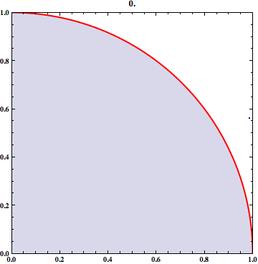
The Monte Carlo simulation methods (MC methods) are a class of computation algorithms which rely on the use of random number sampling and probability statistics to investigate problems. They are particularly useful in exploration of problems which are too complicated to solve analytically. The algorithms may vary, but there is a general pattern they follow; first the inputs are defined and are further generated randomly from a probability distribution, a deterministic computation on these inputs are performed, and finally the results are collected.
Applications include, among others, applied statistics and games, computational biology, mathematics, physics and astrophysics, as well as finance and business, and risk analysis.
Figure: MC method used to approximate the value of number PI. (Example source: http://en.wikipedia.org/MCintro).
For queries about this topic, contact Anna Kapinska.
View the calendar of events relating to this topic.
Projects

Advanced modelling for two-phase reacting flow
Edward Richardson (Investigator)
Engine designers want computer programs to help them invent ways to use less fuel and produce less pollution. This research aims to provide an accurate and practical model for the injection and combustion of liquid fuel blends.

B-meson coupling with relativistic heavy quarks
Jonathan Flynn (Investigator), Ben Samways, Dirk Broemmel, Patrick Fritzsch
We non-perturbatively compute the coupling between B* and B pi meson states relying on relativistic heavy quarks and domain wall light fermions. The coupling is of importance for an effective description of hadronic heavy meson decays.
Body Forces in Particle Suspensions in Turbulence
Gabriel Amine-Eddine (Investigator)
The behaviour of multiphase flows is of primary importance in many engineering applications. In the past, experimental observations have provided many researchers with the ability to understand and probe the phenomena and physical processes occurring in such flows. With advancements in modern day computational power, we now have the ability to gain an even greater wealth of knowledge, from what used to be a physical experiment, is now a virtual simulation.
Amine-Eddine, G.H. (2015) Body forces in particle suspensions in turbulence. University of Southampton, Faculty of Engineering and the Environment, Doctoral Thesis , 283pp.

Cavity-Mediated Cooling
Peter Horak, Timothy Freegarde (Investigators), Andre Xuereb
Optical resonators enhance the interaction of light with matter while simultaneously acting as a temporal buffer. Both effects can be exploited to generate light-induced friction, or cooling, forces on atoms, molecules, or micromirrors. We investigate various aspects of these effects through numerical simulations, assisted by approximate analytical models, in this EPSRC and ESF sponsored project.
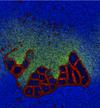
Cellular Automata Modelling of Membrane Formation and Protocell Evolution
Seth Bullock (Investigator), Stuart Bartlett
We simulated the meso-level behaviour of lipid-like particles in a range of chemical and physical environments. Self-organised protocellular structures can be shown to emerge spontaneously in systems with random, homogeneous initial conditions. Introducing an additional 'toxic' particle species and an associated set of synthesis reactions produced a new set of ecological behaviours compared to the original model of Ono and Ikegami.

Centre for Doctoral Training in Next Generation Computational Modelling
Hans Fangohr, Ian Hawke, Peter Horak (Investigators), Susanne Ufermann Fangohr, Thorsten Wittemeier, Kieran Selvon, Alvaro Perez-Diaz, David Lusher, Ashley Setter, Emanuele Zappia, Hossam Ragheb, Ryan Pepper, Stephen Gow, Jan Kamenik, Paul Chambers, Robert Entwistle, Rory Brown, Joshua Greenhalgh, James Harrison, Jonathon Waters, Ioannis Begleris, Craig Rafter
The £10million Centre for Doctoral Training was launched in November 2013 and is jointly funded by EPSRC, the University of Southampton, and its partners.
The NGCM brings together world-class simulation modelling research activities from across the University of Southampton and hosts a 4-year doctoral training programme that is the first of its kind in the UK.

Chip Implementation of a Signal Detector for a Multiple-Input Multiple-Output (MIMO) Wireless System
Mark Zwolinski, Basel Halak, Mohammed El-Hajjar (Investigators), Ibrahim Bello
We implement an Application Specific Integrated Circuit (ASIC) for the signal detection of a MIMO receiver.
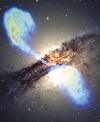
Cosmological evolution of supermassive black holes in the centres of galaxies
Anna Kapinska (Investigator)
Radio galaxies and quasars are among the largest and most powerful single objects known and are believed to have had a significant impact on the evolving Universe and its large-scale structure. Their jets inject a significant amount of energy into the surrounding medium, hence they can provide useful information in the study of the density and evolution of the intergalactic and intracluster medium. The jet activity is also believed to regulate the growth of massive galaxies via the AGN feedback. In this project, through the use of numerical simulations, I explore the intrinsic and extrinsic physical properties of the population of Fanaroff-Riley II (FR II) objects, i.e. their kinetic luminosities, lifetimes, and central densities of their environments. This allows one to investigate evolution of these radio sources across cosmic time, and to discuss the significance of the impact of these sources on the evolving Universe.

Desiging Near-Capacity Quantum Error Correction Codes
Lajos Hanzo (Investigator), Zunaira Babar
Design efficient quantum error correction codes to correct the errors encountered in a quantum transmission; thus, increasing reliability and robustness of the future quantum systems.

Exploring Higgs Boson Physics Beyond the Standard Model
Alexander Belyaev (Investigator), Marc Thomas
The Higgs Boson has recently been discovered at the Large Hadron Collider (LHC) at CERN. The purpose of this project is to look for signs of physics beyond the 'Standard Model' of particle physics by studying properties of this boson.

Fluid Loads and Motions of Damaged Ships
Dominic Hudson, Ming-yi Tan (Investigators), Christian Wood, James Underwood, Adam Sobey
An area of research currently of interest in the marine industry is the effect of damage on ship structures. Research into the behaviour of damaged ships began in the mid nineties as a result of Ro-Ro disasters (e.g. Estonia in 1994). Due to the way the Estonia sank early research mainly focused on transient behaviour immediately after the damage takes place, the prediction of capsize, and of large lateral motions. Further research efforts, headed by the UK MoD, began following an incident where HMS Nottingham ran aground tearing a 50m hole from bow to bridge, flooding five compartments and almost causing the ship to sink just off Lord Howe Island in 2002. This project intends to answer the following questions:
“For a given amount of underwater damage (e.g. collision or torpedo/mine hit), what will be the progressive damage spread if the ship travels at ‘x’ knots? OR for a given amount of underwater damage, what is the maximum speed at which the ship can travel without causing additional damage?”

Hadronic structure on the computer
Jonathan Flynn (Investigator), Dirk Broemmel, Thomas Rae, Ben Samways
In experiments at the Large Hadron Collider (LHC) at CERN, Geneva, the interactions that occur between the colliding particles (protons in this case) can be factorised into a simple scattering between two constituent particles, called quarks, followed by a hadronisation process, which describes the dynamics of forming the bound proton states. Quarks are particles within the proton that bind to form composite particles (hadrons) such as a proton. The scattering process can be computed relatively easily, but hadronisation is intrinsically non-perturbative and hard to calculate. Lattice QCD (computer simulation of QCD on a discrete space-time lattice) provides our only known first-principles and systematically-improvable method to address problems like hadronisation. This project uses Iridis to extract parton distribution amplitudes which are experimentally inaccessible, but needed to describe the quark structure of hadrons.

Hunting for Walking Technicolor at the LHC
Alexander Belyaev (Investigator), Azaria Coupe
Now that the LHC experiment at CERN has observed the Higgs boson, the final piece of the particle physics theory called the Standard Model, the focus of theoretical and experimental physicists shifts to what could possibly be discovered next. Phenomenologists, such as myself, straddle this line between theory and experiment, comparing the many theories of physics Beyond the Standard Model to whatever the LHC discovers, even drawing conclusions from what it doesn’t discover. I focus on a theory called Walking Technicolor (WTC), what the LHC would see if it were correct, and what the lack of discovery so far means for the fate of WTC.

Introducting Defects into the Ising Model
Benjamin Lowe
The well-known Ising model, a model of emergent critical phenomenon and phase transitions, was reimplemented and extended to incorporate the study of defects in the lattice.
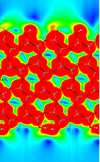
Investigation into the Interfacial Physics of Field Effect Biosensors
Nicolas Green, Chris-Kriton Skylaris (Investigators), Benjamin Lowe
This interdisciplinary research aims to improve understanding of Field Effect Transistor Biosensors (Bio-FETs) and to work towards a multiscale model which can be used to better understand and predict device response.

It takes all sorts: the mathematics of people’s behaviour in financial markets
Valerio Restocchi (Investigator), Frank McGroarty, Enrico Gerding
Agent-based models provide a deeper understanding of financial markets than classic models. We model people's behaviour and use agent-based simulations to study financial markets. By analysing the emerging complex dynamics, we achieve a deeper understanding of market participants' behaviours, which are necessary for a deeper comprehension of financial markets themselves.

Kaon to two pion decays in lattice QCD
Jonathan Flynn (Investigator), Elaine Goode, Dirk Broemmel
We calculate kaon decay amplitudes on the lattice so we may compare the Standard Model to experiment.
Modelling Macro-Nutrient Release & Fate Resulting from Sediment Resuspension in Shelf Seas
Chris Wood
This study involves adapting a previously-published model to take into account the effect resuspension events (both natural and anthropogenic) may have on nutrient dynamics at the sediment-water interface, and hence produce better estimates for the total nutrient budgets for shelf seas.

Modelling micromagnetism at elevated temperature
Hans Fangohr, Kees de Groot, Peter de_Groot (Investigators), Dmitri Chernyshenko
We aim to develop a multiscale multiphysics model of
micromagnetism at elevated temperatures with atomistic simulations for
material parameter. The tool will be used to guide the development of the next generation magnetic data storage technology: heat assisted magnetic recording.

Molecular Fragments in Inhibitor Design
Jonathan Essex (Investigator), Michael Bodnarchuk
Fragment-Based Drug Discovery (FBDD) has emerged as an important tool in the drug discovery process. Instead of screening entire drug molecules, FBDD screens molecular fragments; constituents which make up drug molecules. A computational approach to identifying fragment binding is currently being sought which also yield binding free energy estimation.
Multi-Scale Modelling of Composite Riser Systems
Adam Sobey (Investigator), Hossam Ragheb
There is an ever increasing interest in exploiting ocean resources at greater depths. At these depths composite materials have a larger separation, in terms of benefits, from traditional steel structures as they offer lower maintenance costs, low weight and high durability. However, there are limited current examples of using composites for these applications meaning that empirical knowledge and specific computational tools are limited. As an example of this lack of knowledge current design guidance gives fatigue safety factors in a range of 15-50. Development of more accurate computational tools will allow an increase in safety and/or reduction of the structure.
A key aspect to increasing the usage of flexible composite risers is the ability to assess the reliability of such structures. Importance Sampling Simulation is becoming the preferred method to assess structures which ideally requires a fast and accurate structural modelling method. Whilst Finite Element Methods can provide an accurate solution to these problems they are slow to run. It is therefore proposed to investigate the use of multiscale modelling to investigate the reliability of such structures. This will involve the development of: a full-scale model to be run in conjunction with fluid mechanics simulations, a higher resolution model to investigate the fatigue hotspot near the seabed and a more local model to simulate the fatigue growth.
nano-CMOS
Mark Zwolinski (Investigator), Michael Merrett
Modelling random device variations within systems using nano-CMOS technologies.

Non-Perturbative Renormalisation on the Lattice
Jonathan Flynn (Investigator), Dirk Broemmel, Thomas Rae
In this project we compute renormalisation factors for various physical observables in a non-perturbative lattice framework. Renormalisation hereby arises due to a fundamental scale dependence of the physical processes.
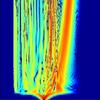
Nonlinear Optical Pulse Propagation
Peter Horak, Francesco Poletti (Investigators)
The work is concerned with the propagation of high-power short-pulse propagation in microstructured fibres or waveguides. Dispersion properties and optical nonlinearities are exploited for pulse shaping techniques in space, time, and frequency. Investigated microstructures include silica or soft-glass templates, gas-filled capillaries, and semiconductor-filled fibres, and optical wavelengths range from the X-ray to the mid-infrared regime.

Origins of Evolvability
Richard Watson, Markus Brede (Investigators), William Hurndall
This project examined the putative evolvability of a Lipid World model of fissioning micelles. It was demonstrated that the model lacked evlovability due to poor heritability. Explicit structure for micelles was introduced along with a spatially localised form of catalysis which increased the strength of selection as coupling between potential chemical units of heredity were reduced.
Porcupine Basin Project
Louise Watremez
The Porcupine Basin is a narrow failed rift, offshore SW Ireland, featuring extreme crustal thinning. The M61/2 survey (May 2004, T. Reston and B. O'Reilly) allowed for the acquisition of seismic refraction data across and along the basin, along 5 transects. The processing of the data along these transects will give us information about the crustal structure across the basin, faulting due to the crustal extension, nature of the upper-mantle, etc. This project is funded by Petroleum Infrastructure Programme (PIP).

Precision study of critical slowing down in lattice simulations of the CP^{N-1} model
Jonathan Flynn, Andreas Juttner (Investigators), Andrew Lawson
This project involves the study of critical slowing down (CSD): a property that may arise when taking measurements in Monte Carlo simulations. In order to study and quantify this phenomenon we have performed extensive simulations of the CP^{N-1} model. By studying the properties of the Monte Carlo algorithms in this model, we hope to make algorithmic improvements that can then be employed in simulations of physical quantum field theories, such as in lattice quantum chromodynamics (lattice QCD).

Prediction of orifice flow flooding rates through generic orifices
Dominic Hudson, Ming-yi Tan (Investigators), Christian Wood, Adam Sobey
This presearch concentrates on the modelling of compartment flooding rates following the occurrence of damage in a ship's side shell. Typical state of the art flooding models use Torricelli’s formula to calculate flooding rates using a constant co-efficient of discharge (Cd). Based on Bernoulli’s theorem, turbulence and viscosity effects are not included using a Cd independent of damage shape or size. Previous work indicates that this assumption over-simplifies the problem to an extent where the flooding rates used for calculation are in error. This project will use CFD validated by experiment to calculate flooding rates for a large number of cases from which a 'krigged' response surface will be generated. Validity of the subsequent response surface will be interrogated.
pyQCD
Matthew Spraggs
A basic Python package to perform coarse lattice QCD simulations on desktop and workstation computers.

Sediment Transfer and Erosion on Large Alluvial Rivers (STELAR-S2S)
Stephen Darby, Julian Leyland, Christopher Hackney (Investigators)
STELAR-S2S will provide the first comprehensive quantification of autogenic and climatic controls on riverine sediment fluxes for one of the world's largest rivers (the Mekong), leading to new generic understanding of the relationships between climatic variability, fluvial processes and sediment flux to deltaic zones and the ocean.

Simulating Household Decision Making in Rural Malawi
James Dyke, Kate Schreckenberg (Investigators), Samantha Dobbie
A scoping exercise to determine whether data collection tools of the social sciences can be used effectively in the construction of empirical ABM. Focus fell upon simulating drought coping strategies of Malawian smallholders. Model implementation enabled inferences to be made concerning the impact of drought and input subsidies upon smallholder food security.
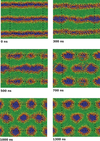
Simulation of biological systems at long length and distance scales
Jonathan Essex (Investigator), Kieran Selvon
This project aims to shed light on cell membrane mechanisms which are difficult to probe experimentally, in particular drug permiation across the cell membrane. If one had a full understanding of the mechanism, drugs could be designed to target particular embedded proteins to improve their efficacy, the viability of nano based medicines and materials could also be assessed, testing for toxicity etc.

Skyrmionic states in confined nanostructures
Hans Fangohr (Investigator), Marijan Beg
An ever increasing need for data storage creates great challenges for the development of high-capacity storage devices that are cheap, fast, reliable, and robust. Because of the fundamental constraints of today's technologies, further progress requires radically different approaches. Magnetic skyrmions are very promising candidates for the development of future low-power, high-capacity, non-volatile data storage devices.
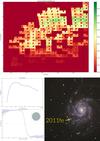
Supernova Rates in the Local Universe
Mark Sullivan (Investigator), Christopher Frohmaier
This project will calculate the frequency of exploding stars -- or supernovae -- in the nearby universe. We simulate a 'toy universe' by exploding billions of stars in a computer, and then artificially 'observing' these explosions by replicating a real astronomical sky survey, the Palomar Transient Factory (PTF). The results of this simulation allows us to discover the rate at which supernovae occur in the local universe each year.
Sustainable domain-specific software generation tools for extremely parallel particle-based simulations
Chris-Kriton Skylaris (Investigator)
A range of particle based methods (PBM) are currently used to simulate materials in chemistry, engineering, physics and biophysics. The 4 types of PBM considered directly in the proposed are molecular dynamics (MD), the ONETEP quantum mechanics-based program, discrete element modelling (DEM), and smoothed particle hydrodynamics (SPH).
The overall research objective is to develop a sustainable tool that will deliver, in the future, cutting edge research applicable to applications ranging from dam engineering to atomistic drug design.

The application and critical assessment of protein-ligand binding affinities
Jonathan Essex (Investigator), Ioannis Haldoupis
A method that can accurately predict the binding affinity of small molecules to a protein target would be imperative to pharmaceutical development due to the time and resources that could be saved. A head-to-head comparison of such methodology, ranging from approximate methods to more rigorous methods, is performed in order to assess their accuracy and utility across a range of targets.
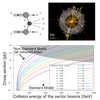
The Higgs Boson at Future Colliders - an Explorative Journey Beyond the Standard Model
Alexander Belyaev (Investigator), Patrick Schaefers
It has been three years since the discovery of a Higgs boson at the CERN LHC and many new insights in Higgs physics were gathered since then. However, its true nature remains unknown to this day. This project aims at exploring the Higgs properties at Future High Energy Colliders beyond the Standard Model to help unveiling its secret.

Today's Computation Enabling Tomorrow's Seamless Communication
Lajos Hanzo (Investigator), Varghese Thomas
Radio Over Fibre (ROF) is a communication technique that aims to gainfully amalgamate the benefits of optical and wireless communication, while keeping the system cost low. This technique would support the next generation of wireless services.

Understanding Stochastic Processes in Interacting Spin Models
Oliver Laslett
Applying efficient computational models to compute Langevin dynamics and master equation equilibrium solutions for interacting magnetic spin systems.

Using computer intensive methods to produce small area estimates of poverty
Nikolaos Tzavidis (Investigator), Steve Donbavand
By using computer intensive methods this work compares, and suggests improvements, to existing methods for estimating poverty levels. These poverty estimates are used to produce maps which in turn help to target government policies.

Vortex Dynamics in High-Tc superconductors
Hans Fangohr (Investigator)
The dynamics of vortices in high temperature superconductors exhibits the complex and rich physics we expect from many body systems with competing interactions. Molecular Dynamics, Langevin Dynamics and Monte Carlo Computer simulations are carried out to understand this system in more detail.

Water Molecules in Protein Binding Sites
Jonathan Essex (Investigator), Michael Bodnarchuk
Water molecules are commonplace in protein binding sites, although the true location of them can often be hard to predict from crystallographic methods. We are developing tools which enable the location and affinity of water molecules to be found.
People
 Seth Bullock
Seth BullockProfessor, Electronics and Computer Science (FPAS)
 Andrew Collins
Andrew CollinsProfessor, Medicine (FM)
 Stephen Darby
Stephen DarbyProfessor, Geography (FSHS)
 Graeme Day
Graeme DayProfessor, Chemistry (FNES)
 Kees de Groot
Kees de GrootProfessor, Electronics and Computer Science (FPAS)
 Jonathan Essex
Jonathan EssexProfessor, Chemistry (FNES)
 Hans Fangohr
Hans FangohrProfessor, Engineering Sciences (FEE)
 Jonathan Flynn
Jonathan FlynnProfessor, Physics & Astronomy (FPAS)
 Lajos Hanzo
Lajos HanzoProfessor, Electronics and Computer Science (FPAS)
 Frank McGroarty
Frank McGroartyProfessor, Management (FBL)
 John Shrimpton
John ShrimptonProfessor, Engineering Sciences (FEE)
 Nikolaos Tzavidis
Nikolaos TzavidisProfessor, Social Sciences (FSHS)
 Mark Zwolinski
Mark ZwolinskiProfessor, Electronics and Computer Science (FPAS)
 Nicolas Green
Nicolas GreenReader, Electronics and Computer Science (FPAS)
 Peter Horak
Peter HorakReader, Optoelectronics Research Centre
 Andreas Juttner
Andreas JuttnerReader, Physics & Astronomy (FPAS)
 Thomas Blumensath
Thomas BlumensathSenior Lecturer, Institute of Sound & Vibration Research (FEE)
 Markus Brede
Markus BredeSenior Lecturer, Electronics and Computer Science (FPAS)
 Timothy Freegarde
Timothy FreegardeSenior Lecturer, Physics & Astronomy (FPAS)
 Dominic Hudson
Dominic HudsonSenior Lecturer, Engineering Sciences (FEE)
 Julian Leyland
Julian LeylandSenior Lecturer, Geography (FSHS)
 Edward Richardson
Edward RichardsonSenior Lecturer, Engineering Sciences (FEE)
 Richard Watson
Richard WatsonSenior Lecturer, Electronics and Computer Science (FPAS)
 Mohamed Bakoush
Mohamed BakoushLecturer, Management (FBL)
 Alexander Belyaev
Alexander BelyaevLecturer, Physics & Astronomy (FPAS)
 James Dyke
James DykeLecturer, Electronics and Computer Science (FPAS)
 Gwenael Gabard
Gwenael GabardLecturer, Institute of Sound & Vibration Research (FEE)
 Basel Halak
Basel HalakLecturer, Electronics and Computer Science (FPAS)
 Ian Hawke
Ian HawkeLecturer, Mathematics (FSHS)
 Denis Kramer
Denis KramerLecturer, Engineering Sciences (FEE)
 Kate Schreckenberg
Kate SchreckenbergLecturer, Civil Engineering & the Environment (FEE)
 Chris-Kriton Skylaris
Chris-Kriton SkylarisLecturer, Chemistry (FNES)
 Ming-yi Tan
Ming-yi TanLecturer, Engineering Sciences (FEE)
 Mark Sullivan
Mark SullivanPrincipal Research Fellow, Physics & Astronomy (FPAS)
 Richard Boardman
Richard BoardmanSenior Research Fellow, Engineering Sciences (FEE)
 Reno Choi
Reno ChoiSenior Research Fellow, Geography (FSHS)
 Francesco Poletti
Francesco PolettiSenior Research Fellow, Optoelectronics Research Centre
 Philip Williamson
Philip WilliamsonSenior Research Fellow, Biological Sciences (FNES)
 Guy Abel
Guy AbelResearch Fellow, Social Sciences (FSHS)
 Petros Bogiatzis
Petros BogiatzisResearch Fellow, Ocean & Earth Science (FNES)
 Dirk Broemmel
Dirk BroemmelResearch Fellow, Physics & Astronomy (FPAS)
 Christopher Hackney
Christopher HackneyResearch Fellow, Geography (FSHS)
 Mathis Hain
Mathis HainResearch Fellow, Ocean & Earth Science (FNES)
 Jason Hilton
Jason HiltonResearch Fellow, Social Sciences (FSHS)
 Jia Huo
Jia HuoResearch Fellow, Chemistry (FNES)
 Ugur Mart
Ugur MartResearch Fellow, Engineering Sciences (FEE)
 Louise Watremez
Louise WatremezResearch Fellow, Ocean & Earth Science (FNES)
 Robin Wilson
Robin WilsonResearch Fellow, Geography (FSHS)
 Grant Aitken
Grant AitkenPostgraduate Research Student, Geography (FSHS)
 Gabriel Amine-Eddine
Gabriel Amine-EddinePostgraduate Research Student, Engineering Sciences (FEE)
 Jordi Arranz
Jordi ArranzPostgraduate Research Student, Electronics and Computer Science (FPAS)
 Stuart Bartlett
Stuart BartlettPostgraduate Research Student, Electronics and Computer Science (FPAS)
 Ioannis Begleris
Ioannis BeglerisPostgraduate Research Student, Engineering Sciences (FEE)
 Michael Bodnarchuk
Michael BodnarchukPostgraduate Research Student, Chemistry (FNES)
 Rory Brown
Rory BrownPostgraduate Research Student, Civil Engineering & the Environment (FEE)
 Jamie Caldwell
Jamie CaldwellPostgraduate Research Student, Engineering Sciences (FEE)
 Daniel Cernin
Daniel CerninPostgraduate Research Student, Mathematics (FSHS)
 Paul Chambers
Paul ChambersPostgraduate Research Student, Engineering Sciences (FEE)
 Dmitri Chernyshenko
Dmitri ChernyshenkoPostgraduate Research Student, Engineering Sciences (FEE)
 Peter Cherry
Peter CherryPostgraduate Research Student, Chemistry (FNES)
 Michael Chesnaye
Michael ChesnayePostgraduate Research Student, Institute of Sound & Vibration Research (FEE)
 Azaria Coupe
Azaria CoupePostgraduate Research Student, Physics & Astronomy (FPAS)
 Paul Cross
Paul CrossPostgraduate Research Student, Engineering Sciences (FEE)
 Samuel Diserens
Samuel DiserensPostgraduate Research Student, Engineering Sciences (FEE)
 Samantha Dobbie
Samantha DobbiePostgraduate Research Student, Electronics and Computer Science (FPAS)
 Caroline Duignan
Caroline DuignanPostgraduate Research Student, Biological Sciences (FNES)
 Robert Entwistle
Robert EntwistlePostgraduate Research Student, Engineering Sciences (FEE)
 Christopher Frohmaier
Christopher FrohmaierPostgraduate Research Student, Physics & Astronomy (FPAS)
 Elaine Goode
Elaine GoodePostgraduate Research Student, Physics & Astronomy (FPAS)
 Stephen Gow
Stephen GowPostgraduate Research Student, Engineering Sciences (FEE)
 Joshua Greenhalgh
Joshua GreenhalghPostgraduate Research Student, Engineering Sciences (FEE)
 Ioannis Haldoupis
Ioannis HaldoupisPostgraduate Research Student, Chemistry (FNES)
 James Harrison
James HarrisonPostgraduate Research Student, Engineering Sciences (FEE)
 Tom Hebbron
Tom HebbronPostgraduate Research Student, Electronics and Computer Science (FPAS)
 William Hurndall
William HurndallPostgraduate Research Student, Electronics and Computer Science (FPAS)
 Joshua Jeeson Daniel
Joshua Jeeson DanielPostgraduate Research Student, Engineering Sciences (FEE)
 Konstantinos Kouvaris
Konstantinos KouvarisPostgraduate Research Student, Electronics and Computer Science (FPAS)
 Oliver Laslett
Oliver LaslettPostgraduate Research Student, Civil Engineering & the Environment (FEE)
 Andrew Lawson
Andrew LawsonPostgraduate Research Student, Physics & Astronomy (FPAS)
 Justin Lovegrove
Justin LovegrovePostgraduate Research Student, Mathematics (FSHS)
 Benjamin Lowe
Benjamin LowePostgraduate Research Student, Electronics and Computer Science (FPAS)
 David Lusher
David LusherPostgraduate Research Student, Engineering Sciences (FEE)
 Sam Mangham
Sam ManghamPostgraduate Research Student, Electronics and Computer Science (FPAS)
 Alvaro Perez-Diaz
Alvaro Perez-DiazPostgraduate Research Student, Engineering Sciences (FEE)
 Lyuboslav Petrov
Lyuboslav PetrovPostgraduate Research Student, Electronics and Computer Science (FPAS)
 Maximillian Phipps
Maximillian PhippsPostgraduate Research Student, Chemistry (FNES)
 Chris Pittock
Chris PittockPostgraduate Research Student, Chemistry (FNES)
 David Potts
David PottsPostgraduate Research Student, Humanities (FH)
 Daniel Powell
Daniel PowellPostgraduate Research Student, Engineering Sciences (FEE)
 Thomas Rae
Thomas RaePostgraduate Research Student, Physics & Astronomy (FPAS)
 Craig Rafter
Craig RafterPostgraduate Research Student, Engineering Sciences (FEE)
 Hossam Ragheb
Hossam RaghebPostgraduate Research Student, Engineering Sciences (FEE)
 Sonya Ridden
Sonya RiddenPostgraduate Research Student, Mathematics (FSHS)
 Álvaro Ruiz-Serrano
Álvaro Ruiz-SerranoPostgraduate Research Student, Chemistry (FNES)
 Ben Samways
Ben SamwaysPostgraduate Research Student, Physics & Astronomy (FPAS)
 Patrick Schaefers
Patrick SchaefersPostgraduate Research Student, Physics & Astronomy (FPAS)
 Kieran Selvon
Kieran SelvonPostgraduate Research Student, Engineering Sciences (FEE)
 Ashley Setter
Ashley SetterPostgraduate Research Student, Engineering Sciences (FEE)
 Adam Sobey
Adam SobeyPostgraduate Research Student, Engineering Sciences (FEE)
 Matthew Spraggs
Matthew SpraggsPostgraduate Research Student, Electronics and Computer Science (FPAS)
 Massimo Stella
Massimo StellaPostgraduate Research Student, Electronics and Computer Science (FPAS)
 Nick Synes
Nick SynesPostgraduate Research Student, Electronics and Computer Science (FPAS)
 Marc Thomas
Marc ThomasPostgraduate Research Student, Physics & Astronomy (FPAS)
 Jonathon Waters
Jonathon WatersPostgraduate Research Student, Engineering Sciences (FEE)
 Iain Weaver
Iain WeaverPostgraduate Research Student, Electronics and Computer Science (FPAS)
 Thorsten Wittemeier
Thorsten WittemeierPostgraduate Research Student, Engineering Sciences (FEE)
 Chris Wood
Chris WoodPostgraduate Research Student, Ocean & Earth Science (FNES)
 Andre Xuereb
Andre XuerebPostgraduate Research Student, Physics & Astronomy (FPAS)
 Emanuele Zappia
Emanuele ZappiaPostgraduate Research Student, Engineering Sciences (FEE)
 Jess Jones
Jess JonesTechnical Staff, iSolutions
 Elena Vataga
Elena VatagaTechnical Staff, iSolutions
 Petrina Butler
Petrina ButlerAdministrative Staff, Research and Innovation Services
 Susanne Ufermann Fangohr
Susanne Ufermann FangohrAdministrative Staff, Civil Engineering & the Environment (FEE)
 Peter de_Groot
Peter de_GrootAlumnus, Physics & Astronomy (FPAS)
 Jan Kamenik
Jan KamenikAlumnus, University of Southampton
 Anna Kapinska
Anna KapinskaAlumnus, ICG, University of Portsmouth
 Gunnar Mallon
Gunnar MallonAlumnus, Geography (FSHS)
 Michael Merrett
Michael MerrettAlumnus, University of Southampton
 Mohsen Mesgarpour
Mohsen MesgarpourAlumnus, University of Southampton
 Christian Wood
Christian WoodAlumnus, Engineering Sciences (FEE)
 Marijan Beg
Marijan BegExternal Member, Imperial College London
 Zunaira Babar
Zunaira BabarNone, None
 Ibrahim Bello
Ibrahim BelloNone, None
 Brian Bonney
Brian BonneyNone, None
 Steve Donbavand
Steve DonbavandNone, None
 Mohammed El-Hajjar
Mohammed El-HajjarNone, None
 Enrico Gerding
Enrico GerdingNone, None
 Valerio Restocchi
Valerio RestocchiNone, None
 Daisuke Sasaki
Daisuke SasakiNone, None
 Andrea Silva
Andrea SilvaNone, None
 Varghese Thomas
Varghese ThomasNone, None